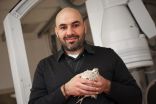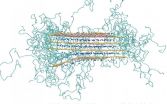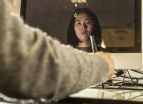INFORMATION:
The research, based at the Birck Nanotechnology Center in Purdue's Discovery Park, are funded in part by the Semiconductor Research Corp.
Writer: Emil Venere, 765-494-4709, venere@purdue.edu
Source: Peide Ye, 765-494-7611, yep@purdue.edu
Related websites:
Peide Ye: http://cobweb.ecn.purdue.edu/~yep/
Birck Nanotechnology Center: http://www.purdue.edu/discoverypark/nanotechnology/
IMAGE CAPTION:
This graphic depicts a new electronic device created at Purdue that uses germanium as the semiconductor instead of silicon. Germanium is one material being considered to replace silicon in future chips because it could enable the industry to make smaller transistors and more compact integrated circuits. (Purdue University image)
A publication-quality photo is available at http://news.uns.purdue.edu/images/2014/ye-germanium.jpg
ABSTRACT
First Experimental Demonstration of Ge CMOS Circuits
Heng Wu, Nathan Conrad, Wei Luo, and Peide D. Ye*
School of Electrical and Computer Engineering, Purdue University
*Tel: 1-765-494-7611, Fax: 1-765-496-6443, Email: yep@purdue.edu
We report the first experimental demonstration of Ge CMOS circuits, based on a novel recessed channel and S/D technique. Aggressively scaled non-Si CMOS logic devices with channel lengths (Lch) from 500 to 20 nm, channel thicknesses (Tch) of 25 and 15 nm, EOTs of 4.5 and 3 nm and a small width ratio (Wn:Wp=1.2) are realized on a Ge-on-insulator (GeOI) substrate. The CMOS inverters have high voltage gain of up to 36 V/V, which is the best value among all of the non-Si CMOS results by the standard top-down approach. Scalability studies on Ge CMOS inverters down to 20 nm are carried out for the first time. NAND and NOR logic gates are also investigated.
Germanium comes home to Purdue for semiconductor milestone
2014-12-09
(Press-News.org) WEST LAFAYETTE, Ind. - A laboratory at Purdue University provided a critical part of the world's first transistor in 1947 - the purified germanium semiconductor - and now researchers here are on the forefront of a new germanium milestone.
The team has created the first modern germanium circuit - a complementary metal-oxide-semiconductor (CMOS) device - using germanium as the semiconductor instead of silicon.
"Bell Labs created the first transistor, but the semiconductor crystal made of purified germanium was provided by Purdue physicists," said Peide "Peter" Ye, a Purdue professor of electrical and computer engineering.
Germanium was superseded by silicon as the semiconductor of choice for commercial CMOS technology. However, the industry will soon reach the limit as to how small silicon transistors can be made, threatening future advances. Germanium is one material being considered to replace silicon because it could enable the industry to make smaller transistors and more compact integrated circuits, Ye said.
Compared to silicon, germanium also is said to have a "higher mobility" for electrons and electron "holes," a trait that makes for ultra-fast circuits.
In new findings, Purdue researchers show how to use germanium to produce two types of transistors needed for CMOS electronic devices. The material had previously been limited to "P-type" transistors. The findings show how to use the material also to make "N-type" transistors. Because both types of transistors are needed for CMOS circuits, the findings point to possible applications for germanium in computers and electronics, he said.
Findings will be detailed in two papers being presented during the 2014 IEEE International Electron Devices Meeting on Dec. 15-17 in San Francisco. One paper was authored by Ye and graduate students Heng Wu, Nathan Conrad and Wei Luo, the same authors of the second paper together with graduate students Mengwei Si, Jingyun Zhang and Hong Zhou.
The material has properties that make it difficult to create an N-type contact with low electrical resistance for good current flow. However, the germanium is doped, or impregnated with impurities that alter its properties. The areas containing the most impurities have the lowest resistance. The researchers showed how to etch away the top layer of germanium, exposing the most heavily doped portion, which provides a good contact.
The etching creates recessed channels, which serve as gates needed for CMOS transistors to switch on and off. Findings show the fundamental part of the circuit, called the inverter, is the best-performing non-silicon inverter demonstrated so far, Ye said.
ELSE PRESS RELEASES FROM THIS DATE:
Too many returns this holiday? How loyal customers can hurt sales
2014-12-09
Many people have strong habits when it comes to shopping, preferring favorite stores and favorite brands. But a new study in the Journal of Marketing Research suggests that these same shoppers may have hidden habits that are hurting sales.
"Evidence suggests the existence of customer habits, beyond repeat purchases, that have serious implications for profits and firm performance. Whereas repeat purchase habits have been studied and shown to have a positive impact on sales, there are other common habits which have a notably negative effect on a company's bottom line," ...
Twitter posts may shine a fresh light on mental illness trends
2014-12-09
Johns Hopkins computers scientists, who have already used Twitter posts to track flu cases, say their techniques also show promise as a tool to gather important information about some common mental illnesses.
By reviewing tweets from users who publicly mentioned their diagnosis and by looking for language cues linked to certain disorders, the researchers say, they've been able to quickly and inexpensively collect new data on post-traumatic stress disorder, depression, bipolar disorder and seasonal affective disorder.
In research presented at three scientific conferences ...
Controlling obesity with potato extract
2014-12-09
Take a look in your pantry: the miracle ingredient for fighting obesity may already be there. A simple potato extract may limit weight gain from a diet that is high in fat and refined carbohydrates, according to scientists at McGill University. The results of their recent study were so surprising that the investigators repeated the experiment just to be sure.
Investigators fed mice an obesity-inducing diet for 10 weeks.
The results soon appeared on the scale: mice that started out weighing on average 25 grams put on about 16 grams. But mice that consumed the same diet ...
'Tis the season for youth to curb binge-drinking
2014-12-09
This news release is available in French. Montreal, December 9, 2014 -- With the holidays around the corner, we're all a little more likely to indulge, especially when it comes to alcohol. While a few extra drinks might be brushed off as holiday cheer, they can actually signal a problem in young adults.
That's because the bad habits we pick up in our youth may stay with us later in life, according to a new study from Concordia, in collaboration with the Université de Montréal and University of Massachusetts.
Its findings, which were published recently ...
Holiday contributions: What makes people upgrade to a recurring donation?
2014-12-09
Smaller recurring donations are generally more beneficial to a non-profit than larger, one-time donations, yet non-profits struggle to convince donors to move beyond one-time contributions. According to a new study in the Journal of Marketing Research, if donors believe that upgrading to a recurring donation will result in a matching donation, many will make the leap.
"Imagine you are given the option to upgrade to a recurring donation. Now imagine that the charity will match all donations made that day, if and only if 75% of donors agree to upgrade to a recurring donation. ...
What quails can teach us about the gait of dinosaurs
2014-12-09
Dinosaurs did it. Human beings and monkey do it. And even birds do it. They walk on two legs. And although humans occupy a special position amongst mammals as they have two legs, the upright gait is not reserved only for man. In the course of evolution many animals have developed the bipedal gait - the ability to walk on two legs.
"Birds are moving forward on two legs as well, although they use a completely different technique from us humans," Dr. Emanuel Andrada from the Friedrich Schiller University in Jena (Germany) says. Human beings keep their upper bodies generally ...
Composite materials can be designed in a supercomputer 'virtual lab'
2014-12-09
UCL scientists have shown how advanced computer simulations can be used to design new composite materials. Nanocomposites, which are widely used in industry, are revolutionary materials in which microscopic particles are dispersed through plastics. But their development until now has been largely by trial and error.
The 'virtual lab' developed using supercomputer simulations greatly improves scientists' understanding of how composite materials are built on a molecular level. They allow the properties of a new material to be predicted based simply on its structure and ...
Online students give instructors higher marks if they think instructors are men
2014-12-09
A new study shows that college students in online courses give better evaluations to instructors they think are men - even when the instructor is actually a woman.
"The ratings that students give instructors are really important, because they're used to guide higher education decisions related to hiring, promotions and tenure," says Lillian MacNell, lead author of a paper on the work and a Ph.D. student in sociology at NC State. "And if the results of these evaluations are inherently biased against women, we need to find ways to address that problem."
To address whether ...
Cancer therapy shows promise for nuclear medicine treatment
2014-12-09
Reston, Va. (December 9, 2014) - Cancer therapy can be much more effective using a new way to customize nuclear medicine treatment, researchers say in the December 2014 issue of The Journal of Nuclear Medicine. The process could also be useful for other diseases that could benefit from targeted radiation.
Targeted therapy with radiopharmaceuticals--radioactive compounds used in nuclear medicine for diagnosis or treatment--has great potential for the treatment of cancer, especially for cancer cells that have migrated from primary tumors to lymph nodes and secondary organs ...
Distraction, if consistent, does not hinder learning
2014-12-09
PROVIDENCE, R.I. [Brown University] -- Maybe distraction is not always the enemy of learning. It turns out in surprising Brown University psychology research that inconsistent distraction is the real problem. As long as our attention is as divided when we have to recall a motor skill as it was when we learned it, we'll do just fine, according to the new study.
Most learned motor tasks -- driving, playing sports or music, even walking again after injury -- occur with other things going on. Given the messiness of our existence, said lead researcher Joo-Hyun Song, assistant ...



